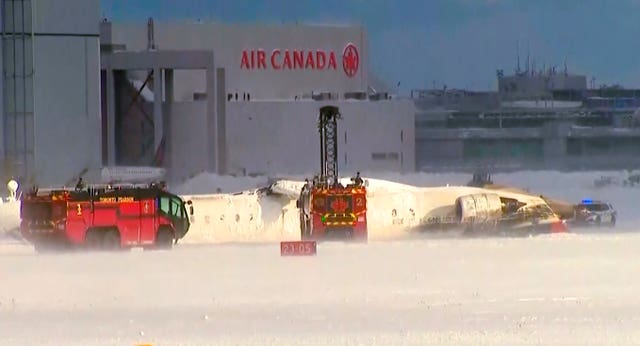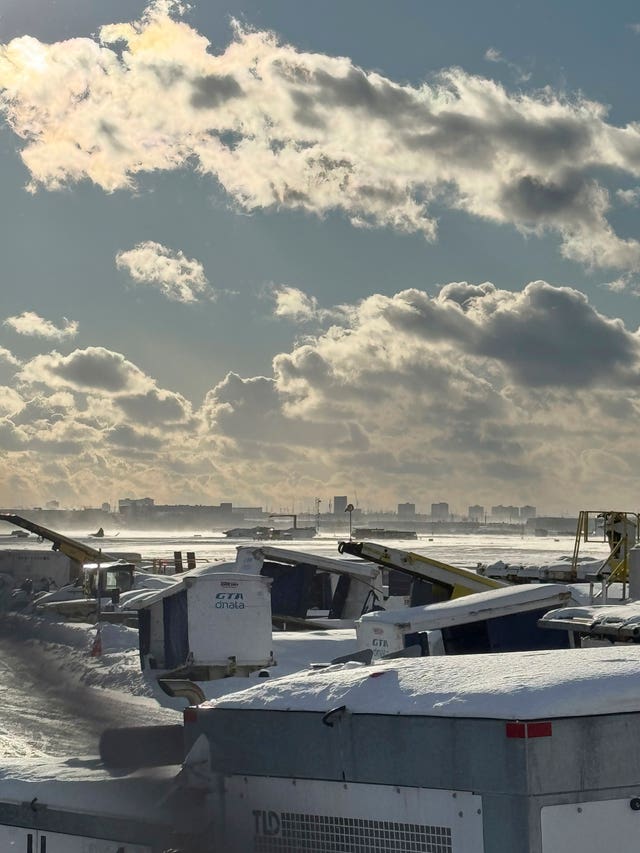19 injured as Delta Airlines plane overturns on landing at Toronto airport
Video from the scene showed the plane upside down on the snowy tarmac at Pearson Airport.

An airliner has overturned on arrival at Toronto’s Pearson Airport and ended up on its roof, injuring 19 people including three who are in critical condition.
The airport confirmed on X that an “incident” occurred with the Delta Airlines flight from Minneapolis and that 76 passengers and four crew are accounted for.
Video from the scene shows the Mitsubishi CRJ-900LR upside down on the snowy tarmac as emergency workers hose it down. The plane was partly obscured by snow from a winter storm that hit Toronto over the weekend.
Ornge air ambulance said it was transporting one young patient to Toronto’s SickKids Hospital and two adults with critical injuries to other hospitals in the city.

“Emergency teams are responding,” the airport said in a post on the social platform X. “All passengers and crew are accounted for.”
It is too early to say what caused the plane to overturn but weather may have played a factor. According to the Meteorological Service of Canada, the airport was experiencing blowing snow and winds of 32mph gusting to 40mph. The temperature was about minus 8.6C.
“It’s very rare to see something like this,” said John Cox, chief executive of aviation safety consulting firm Safety Operating Systems in St Petersburg, Florida. “We’ve seen a couple of cases of takeoffs where airplanes have ended up inverted, but it’s pretty rare.”
Mr Cox said the CRJ900 aircraft is a proven aircraft which has been in service for decades and does a good job of handling inclement weather.
“The weather conditions were windy. The wind was out of the west at 27 to 35 knots, which is about 38 miles an hour. So it was windy. But the airplanes are designed and certified to handle that. The pilots are trained and experienced to handle that.”
The Federal Aviation Administration said in a statement that the Transportation Safety Board of Canada would lead the investigation and provide updates. The National Transportation Safety Board said it is leading a team of US investigators to assist the investigation.

It is at least the fourth major aviation mishap in North America in the past month. A commercial jetliner and an army helicopter collided near Washington DC on January 29, killing 67 people, a medical transport plane crashed in Philadelphia on January 31, killing the six people on board and another person on the ground, and 10 were killed in a plane crash in Alaska.
Delta said in a statement that “initial reports were that there are no fatalities”.
“Several customers with injuries were transported to area hospitals. Our primary focus is taking care of those impacted,” the airline added.
Ontario’s premier Doug Ford said on X he was “relieved there are no casualties after the incident at Toronto Pearson”. Toronto is the capital of Ontario.
“Provincial officials are in contact with the airport and local authorities and will provide any help that’s needed,” he added.
Endeavour Air, based in Minneapolis, is a subsidiary of Delta Air Lines and the world’s largest operator of CRJ-900 aircraft. The airline operates 130 regional jets on 700 daily flights to more than 126 cities in the US, Canada and the Caribbean, according to the company’s website.
The CRJ900, a popular regional jet, was developed by Canadian aerospace company Bombardier. It is in the same family of aircraft as the CRJ700, the type of plane involved in the midair collision near Reagan National Airport on January 29.





